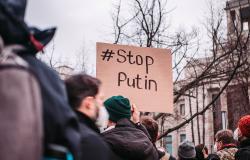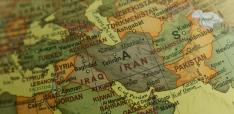Ukraine’s Defense in a Trump World: Can Europe Fill the Gap?

Samuel Johnson-Saeger and Hilary Appel argue that Europe has had many reasons to fear the loss of American support.
Despite the minerals deal announced by Ukraine and the United States on April 30, 2025, the Trump administration refuses to offer Ukraine concrete security guarantees. Given the tremendous uncertainty surrounding US military support for Ukraine, European leaders are working aggressively to identify which military areas they can assume and which areas are beyond their current capacities in helping Ukraine protect itself against Russian aggression.
While America’s contribution to air defense, intelligence, and longer-range missiles are especially important and hard to replace in the short term, other defense areas are less vulnerable to a U.S. withdrawal. In addition to examining the material limitations hampering European effectiveness in supporting Ukraine’s future defense, it is crucial to recognize the key political challenges at both the domestic and the EU level that will constrain Europe’s ability to absorb the role played by US military support.
Reacting to a Faltering American Commitment
Even before the November 2024 presidential elections, European alarm bells sounded when the Republican-controlled House under pressure from Donald Trump delayed a vote on a bill allocating $61bn in new Ukrainian aid for nearly six months before approving it on April 23, 2024. With the second election of Donald Trump to the White House, European leaders were aware that their countries would have to do more to support Ukraine’s defense. This reality became all the more urgent after Trump temporarily blocked weapons transfers over the Polish border and ceased intelligence sharing following an acrimonious exchange in the Oval Office with President Zelensky on February 28, 2025.
Since this confrontation, European leaders have scrambled to convince the Trump administration to continue US support and reaffirm their own commitments, gathering in meeting after meeting to rally more resources for Ukraine and identify immediate vulnerabilities that would result from a full withdrawal of US support. While the previously allocated American support for Ukraine resumed days later, Finland, France, Norway, the UK, and Germany all subsequently announced new aid packages for Ukraine’s defense. Meeting at NATO headquarters for the Ukraine Defence Contact Group (UDCG), European governments on April 11, 2025 announced $24bn in additional military support for Ukraine, more than half of which will come from Germany over the next four years.
The minerals deal raises questions for policymakers on both sides of the Atlantic about Ukraine’s ability to rally support for its defense. For Washington, claiming to seek long-term economic ties to Ukraine while demanding that Europeans shoulder more of the defense burden, pull-back may be highly problematic given that certain areas depend strongly upon US technical and industrial capacity. For the Europeans, it requires a consideration of what significant military, as well as political and institutional, challenges they face in continuing to support Ukraine’s defense should the minerals deal prove hollow or Trump’s demands escalate.
Europe’s Defense Capabilities and Deficits
America’s contribution to air defense, intelligence, and longer-range missiles are hard to replace in the short and medium term. For example, Ukraine relies heavily on US intelligence to conduct a variety of military operations, particularly missile defense and targeting. Relatedly, Ukraine depends overwhelmingly upon the US for long-range air defense systems, with approximately 70% of them coming from US production. Ukraine also depends substantially on US artillery, with 86% of HIMARS multiple-launch rocket systems (MLRSs) and 80% of Howitzer artillery ammunition coming from US production, according to estimates from the Kiel Institute.
Other areas are less concerning. Based on past contributions, the UK, Germany, Spain, Italy, and France can continue to be helpful in supporting Ukraine’s short and medium- range air defenses. Moreover, Europe has provided significant contributions of battle tanks to Ukraine, but production capacity may be unsustainable given past reliance on existing stockpiles over new production. One area of technology where Ukraine can most rely on its own defense capabilities is in drones. While European capital investment is needed to ramp up production, Ukraine has achieved extraordinary growth in its domestic drone manufacturing capacity.
Europe’s ability to support Ukraine’s defense will nonetheless require major upgrades to the continent’s defense industrial base. In areas like guided weapons, tanks, and aircraft, production capacity is poor. Meanwhile, Russia continues to invest heavily in its military, outproducing the whole of Europe.
Overcoming Political Challenges at the Domestic and EU Level
Beyond these limitations, there are significant political and institutional hurdles that must be overcome to help Ukraine defend itself against Russian attacks. Fortunately, political support for Ukraine at the elite level remains strong. European governments, with few exceptions, reaffirm their country’s support with pledges of further assistance; but given public opinion data, leaders will likely face growing domestic political headwinds in the near term.
Recent YouGov polling from December 2024 showed that desire to support Ukraine until it wins the war had fallen in every country surveyed. This was particularly true in Southern European countries like Spain and Italy, which have so far shown more hesitation to use their expanded borrowing capacity to finance Ukraine’s defense. Whether an actual conclusion of US support for Ukraine’s defense or demands for further increases in European assistance would sway popular support for increased spending on Ukraine is hard to predict. Will the voting European publics see spending on Ukraine’s defense as necessary for their own national defense? This remains to be seen.
Even Poland, which surpasses other countries in both spending targets and the absorption of Ukrainian refugees, has nonetheless faced significant domestic political challenges related to the Russia-Ukraine war, including trucker roadblocks and boycotts of Ukrainian grain imports. Sympathy with these actions is remarkably high, with polls reporting that 81% of Poles supported farmers protests over inflows of Ukrainian agricultural products.
Beyond ensuring popular support for more spending at home, European leaders have to overcome collective action problems associated with committing funds and even soldiers unevenly across the EU and UK. Most recently, when European leaders attempted to commit all member states to making mandatory contributions to Ukrainian defense in late March, staunch opposition emerged. Kaja Kallas, the EU’s chief foreign policy and security official, proposed a small, fixed percentage levy on each country’s national income to raise €40 billion for Ukrainian aid, but the proposal was quickly abandoned. Even Kallas’s more modest proposal for €5 billion in artillery ammunition raised via mandatory contributions was blocked by Italy, Slovakia, and France. Only a proposal with voluntary contributions was found acceptable.
Even if Europe can finance Ukrainian defense, it may face hurdles in establishing meaningful security guarantees without the United States. US economic interest in other countries has never before been enough to imply a nuclear deterrent, and the minerals deal is no different. Indeed, the absence of a US nuclear deterrent is not easily replaced by France and Great Britain’s more modest nuclear arsenals, which are designed to serve as their own strategic deterrents. Not only do they together have less than a third the number of warheads as the US, neither country’s nuclear deterrent operates in the same forward-deployed manner. It is for this reason that American support, and more specifically American troops, could be a powerful deterrent to Russia breaking any possible future ceasefire agreement. There is an implicit link between an attack on American military personnel and the US’s vast forward nuclear capabilities.
The greater challenge to deploying European troops, however, is not the absence of American troops, but the collective action problem associated with a small number of countries risking the lives of their citizens. Initially, the prospect of putting European boots on the ground in Ukraine, at the very least to maintain a potential ceasefire, seemed possible. France and the United Kingdom both floated putting thousands of troops in Ukraine despite Russia insisting it would reject any NATO troop presence.
However, most other European countries have balked at the idea of sending troops without a US security guarantee, which contributes to the collective action problem and the slim prospect of a united European front. The French and British publics may come to resent the lack of other Europeans risking their lives in the defense of Ukraine and by extension Europe.
In sum, Europe has had many reasons to fear the loss of American support for Ukraine and doubt the transatlantic alliance more broadly. While the minerals deal is a loss for Putin, there is no guarantee that it will be a sufficient incentive for Trump to provide Ukraine the defense support it needs. The Europeans must boost military, industrial and intelligence capacities, not to mention overcome political and institutional hurdles, to prepare for security challenges. These are challenges posed not only by Ukraine’s immediate defense but also longer-term unforeseen threats to European security resulting from a weakened transatlantic alliance and a less dependable US nuclear umbrella.
Hilary Appel is the Podlich Family Professor of Government at Claremont McKenna College and the Director of the Keck Center for International and Strategic Studies. Appel has published multiple books and articles on East European politics and political economy, EU and NATO
enlargement, and Russian foreign policy.
Samuel Johnson-Saeger studies international relations and economics at Claremont McKenna and works at the Keck Center for International and Strategic Studies. Johnson-Saeger has interned with the Council on Foreign Relations, Chemonics International, and the Risk Analysis and Surveillance Division at the Federal Reserve Bank of San Francisco.
Photo by Matti Karstedt


